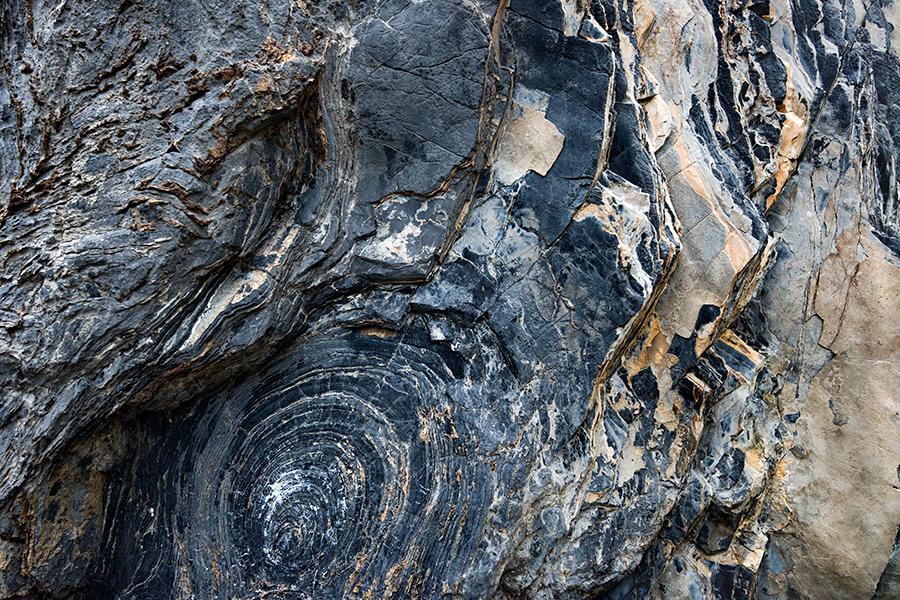As the National Park Service observes its 100th birthday, there’s nothing quite like Glacier National Park’s evolutionary clock, and especially its Precambrian Belt-series rock, to make the agency look young again.
In Glacier, it’s easy to keep time in perspective while gazing up at a centuries-old whitebark pine tree a dozen feet in diameter. Another birthday loses its significance when one considers how the scalpels of glaciers sculpted the park’s soaring mountains and sprawling valleys over the course of hundreds of thousands of years, during countless cycles of glacial advance and retreat.
And yet even the trees and glaciers appear as fleeting as a hummingbird when you spy the billion-year-old fossil embedded in the limestone wall nearby.
It’s called a stromatolite, and it ranks among the planet’s oldest fossils. It also serves as evidence of Earth’s earliest life.
Fortunately for denizens of Northwest Montana and visitors to Glacier National Park, these rare specimens are plentiful in a region characterized by its layered, sedimentary rock formations.
Stromatolites look like blue-gray, stone cabbage heads clumped together, with each head about a foot in diameter. They are rocks squirreled away in time’s dusty attic, from a period that predates animals or land plants, and they are remarkably preserved by comparison with other old-rock sites on Earth.
They grew at a time when Glacier National Park’s landscapes were much different from today, explained Teagan Tomlin, an interpretive ranger and geologist at Glacier.
“When stromatolites formed in what is today Glacier National Park, this area was covered in a giant water body, likely a sea that we call the Belt Sea,” Tomlin said. “This water body was likely a warm, shallow sea in a landscape barren of vegetation. A world with no plants, shrubs or trees means tons of erosion. While that sea was here, the massive erosion led to the deposition of more than 10,000 feet of sediment that would become the massive mountains we so enjoy in Glacier National Park.”
Stromatolites formed in the bottoms of the warm, shallow sea, and became responsible, through photosynthesis, for the oxygen-rich atmosphere that humans, plants and animals live in today. As part of their metabolism, they’d take in sunlight and carbon dioxide, and, in turn, release oxygen.
“Back then, they were the only large organism on the planet,” Tomlin said. “They likely paved the way for life as we know it, being major oxygen producers that existed before our modern-day oxygen producers existed, such as trees.”
Composed of layers of blue-green algae, stromatolites form a wide variety of shapes: conical, stratiform, branching, domal, and columnar. During the Precambrian (4,500 to 500 million years ago), stromatolites were abundant and widespread, forming reef-like structures known as bioherms.
The single-celled algae grew in large mats, expanding toward the light by day, while at night, new sediment from the salty tide pools surrounding them would cover their surface. The repetitive process resulted in layers of bloom and rock that show up clearly when cut cross-section.
“They can look different depending on the orientation of how they were weathered or eroded,” Tomlin explained. “Imagine if I cut a mound with a machete. If I wacked it straight down, from top to bottom, it will look like a mound of many fine layers. If I machete chopped it parallel to the ground and chopped the top off, it will look more like a bull’s eye or a licked jawbreaker. And if it is cut at an angle, it will look like a thumbprint.”
Tomlin enjoys telling park visitors about stromatolites because, as she puts it, “they represent a different Montana than the one we are familiar with today.”
Stromatolites persist in the modern world in places where they are protected from grazing predators like snails, but they used to be so abundant that the sheer volume of oxygen they produced significantly changed the composition of our atmosphere.
“The stromatolites in the park are certainly very beautiful and interesting and have a long history,” said Don Winston, geology professor emeritus at the University of Montana, who has mapped a vast basin — an ancient proterozoic seabed — into which sediments layered up to 18 kilometers thick. “It is a classic area to study stromatolites, which made our planet suitable for organisms like us.”
Tomlin said there are several spots in Glacier Park where hikers can easily access these fossils. The Highline Trail is probably the best hike to find stromatolites, she said, which are captured in a large boulder field below Haystack Butte, just before the big switchback.
There is also a neat outcrop of stromatolites along the Going-to-the-Sun Road heading from Lake McDonald to The Loop, en route to Logan Pass approximately one-third of a mile before the tunnel.
Another spot to view stromatolites is at Grinnell Glacier, she said.
“They represent a totally different world,” she said.
